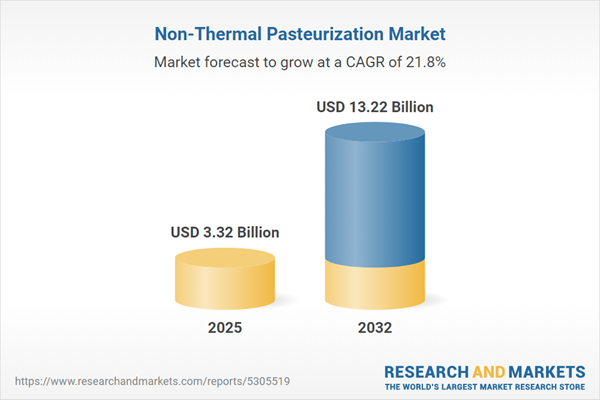Speak directly to the analyst to clarify any post sales queries you may have.
The Non-Thermal Pasteurization Market is undergoing a significant transformation, driven by demand for effective food safety solutions that support both quality and sustainability across the value chain. As regulatory frameworks evolve and technology advances, senior leaders are strategically reassessing investments to stay ahead in this rapidly shifting environment.
Market Snapshot: Non-Thermal Pasteurization Market Growth and Trends
The global non-thermal pasteurization market grew from USD 2.73 billion in 2024 to USD 3.32 billion in 2025. It is anticipated to continue expanding at a CAGR of 21.78%, reaching USD 13.22 billion by 2032. This accelerated growth reflects the sector’s alignment with heightened consumer expectations for minimally processed foods and stricter food safety regulations. Diverse processing methods that preserve nutritional and sensory qualities without applying heat are becoming critical differentiators for food manufacturers and suppliers.
Scope & Segmentation
- Product Types: Dairy products, juice and beverages, meat and seafood products, and processed fruits and vegetables are being addressed through tailored pasteurization approaches.
- Technologies: The adoption of cold plasma, high pressure processing, ozone treatment, pulsed electric field, ultrasound, and ultraviolet systems enables targeted pathogen inactivation for diverse food categories.
- Equipment Models: Both batch and continuous systems meet varying throughput needs, production flexibility, and investment criteria.
- End User Groups: Food service providers, manufacturing plants, and retail outlets deploy non-thermal methods to match operational scale and regulatory needs.
- Packaging Formats: Innovation is advancing across bottles, cans, cartons, and pouches, each presenting unique process and barrier requirements.
- Distribution Channels: Direct sales, distributors, and online channels shape go-to-market strategies, logistics, and customer engagement.
- Geographic Regions: Coverage includes the Americas (North America, Latin America), Europe, Middle East & Africa, and Asia-Pacific, with regional variations in adoption and regulatory support.
- Leading Companies Profiled: Hiperbaric S.A., GEA Group Aktiengesellschaft, SPX FLOW, Inc., Krones AG, Elea GmbH, American Pasteurization Company, Impact Consumer Products Group, John Bean Technologies Corporation, thyssenkrupp Uhde GmbH, Zwirner Equipment Corporation.
Key Takeaways for Senior Decision-Makers
- The non-thermal pasteurization market is reshaping food safety by providing methods that retain product freshness and nutritional value while minimizing environmental impact.
- Rapid technological advancements such as advanced process monitoring, modular equipment, and inline diagnostics are enabling scalable and efficient implementation for diverse product lines.
- Regulatory shifts support non-thermal processing as an accepted safety validation path, lowering compliance barriers for companies adopting these solutions.
- Growing consumer demand for clean-label and high-quality foods continues to catalyze investments and industry partnerships in non-thermal technologies.
- Strategic alliances among technology providers, equipment manufacturers, and food industry stakeholders are accelerating innovation and standardization, strengthening the overall ecosystem.
Tariff Impact: Navigating Supply Chain and Manufacturing Challenges
Recent U.S. tariffs in 2025 have introduced new capital considerations for companies reliant on imported processing equipment, prompting a shift toward domestic sourcing and local manufacturing. These regulatory measures are influencing sourcing strategies, encouraging regional assembly operations, and driving innovation in equipment modularity. Organizations are increasingly factoring in geopolitical risk and tariff exposure to fortify supply chain resilience and optimize long-term investment planning.
Methodology & Data Sources
This report’s insights are rooted in extensive primary interviews with executives, technology innovators, and end-user representatives, as well as secondary research encompassing technical literature, regulatory filings, and patent reviews. Quantitative analysis draws from equipment shipment data and regional trade statistics, offering a robust, triangulated perspective for reliable strategy development.
Why This Report Matters
- Provides actionable intelligence for optimizing product quality, food safety, and sustainability initiatives with non-thermal methods.
- Enables benchmarking and scenario planning by mapping market segmentation, technology trends, and regional factors impacting adoption.
- Equips executive leadership with a validated framework for risk mitigation, investment prioritization, and strategic partnerships.
Conclusion
Non-thermal pasteurization is setting new standards in food safety and product innovation. By leveraging technology adoption and partnership strategies, businesses can proactively navigate changing market forces, safeguard brand value, and achieve sustainable growth.
Additional Product Information:
- Purchase of this report includes 1 year online access with quarterly updates.
- This report can be updated on request. Please contact our Customer Experience team using the Ask a Question widget on our website.
Table of Contents
3. Executive Summary
4. Market Overview
7. Cumulative Impact of Artificial Intelligence 2025
List of Figures
Samples

LOADING...
Companies Mentioned
The key companies profiled in this Non-Thermal Pasteurization market report include:- Hiperbaric S.A.
- GEA Group Aktiengesellschaft
- SPX FLOW, Inc.
- Krones AG
- Elea GmbH
- American Pasteurization Company
- Impact Consumer Products Group
- John Bean Technologies Corporation
- thyssenkrupp Uhde GmbH
- Zwirner Equipment Corporation
Table Information
| Report Attribute | Details |
|---|---|
| No. of Pages | 199 |
| Published | October 2025 |
| Forecast Period | 2025 - 2032 |
| Estimated Market Value ( USD | $ 3.32 Billion |
| Forecasted Market Value ( USD | $ 13.22 Billion |
| Compound Annual Growth Rate | 21.7% |
| Regions Covered | Global |
| No. of Companies Mentioned | 11 |









